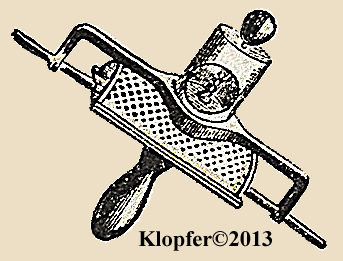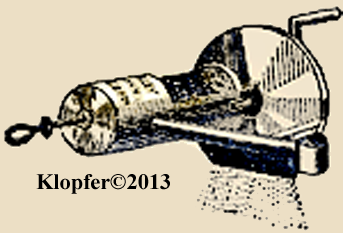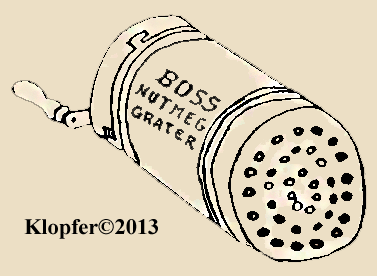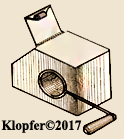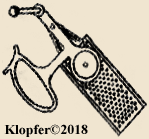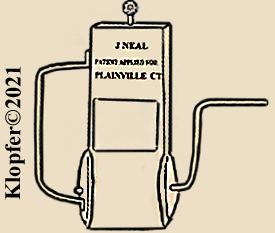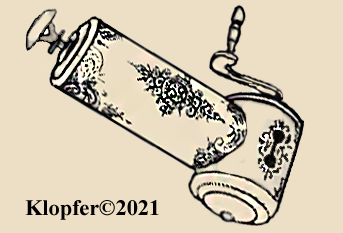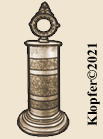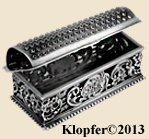 Click Me!
Click Me!
NutmegGraters.Com

- Home
- Featured Stories
- Picture Gallery
- Info.Wanted :
- Spurious Marks
- Trading Post
- Contact Our Site
- Wanted To Buy
[WELCOME: My articles published on NutmegGraters.Com and commercially (elsewhere) required many years of primary research, personal expense, travel and much effort to publish. This is provided for your enjoyment, it is required that if quoting my copyrighted text material, directly provide professionally appropriate references to me. Images are unavailable for copy. Thank you J. Klopfer.]
_______________________________________________________________________________________________________________________________________________________
Identifying Characteristics Of Ivory And Bone Nutmeg Graters
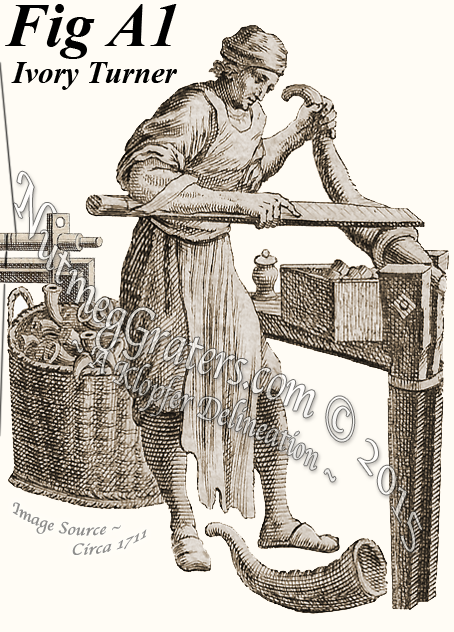 Archeological excavation reveal that bone and ivory tools and trinkets were produced across the millennia; with some sources claiming these items date as early as Circa 33000 ~ 30000 BCE. Ivory is obtained from the teeth of sperm whale or hippopotamus, and the tusks of elephants, wild boars, walrus or narwhals (to include the long extinct mammoths and mastodons). Bone is the skeletal structure from vertebrates.
Archeological excavation reveal that bone and ivory tools and trinkets were produced across the millennia; with some sources claiming these items date as early as Circa 33000 ~ 30000 BCE. Ivory is obtained from the teeth of sperm whale or hippopotamus, and the tusks of elephants, wild boars, walrus or narwhals (to include the long extinct mammoths and mastodons). Bone is the skeletal structure from vertebrates.
Turned carvings in ivory date earlier than the seventh century. Ivory turners (Fig A1) used bone, horn and ivory, as well as wood. The pole lathe was first invented by the thirteenth century (Fig A2). Invented about 1500, the foot wheel lathe (Fig A3) was a refinement in lathes allowing more complex and refined hollow turning; notice the three finished egg form carvings at the center of the workbench.
Originating in Germany during the early sixteenth century, serving as art patrons, the wealthy nobility sponsored ivory turners and other skilled artisans to live and work within their royal courts. During this period, these selected ivory turners developed complex lathe technology, which allowed them to create intricate and magnificent ornamental turnings, as never seen before, using African elephant tusks.
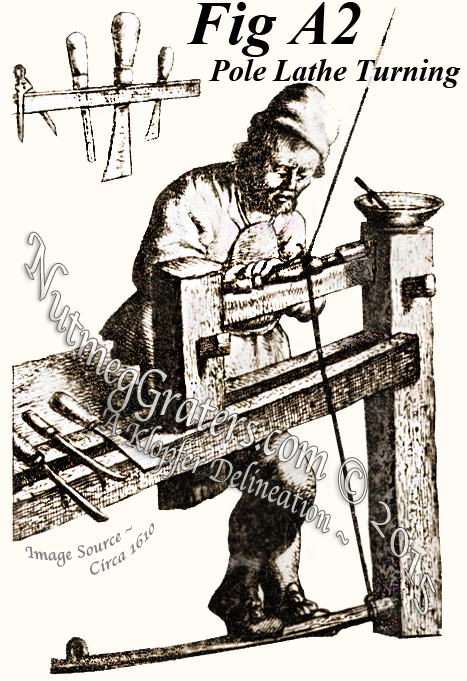
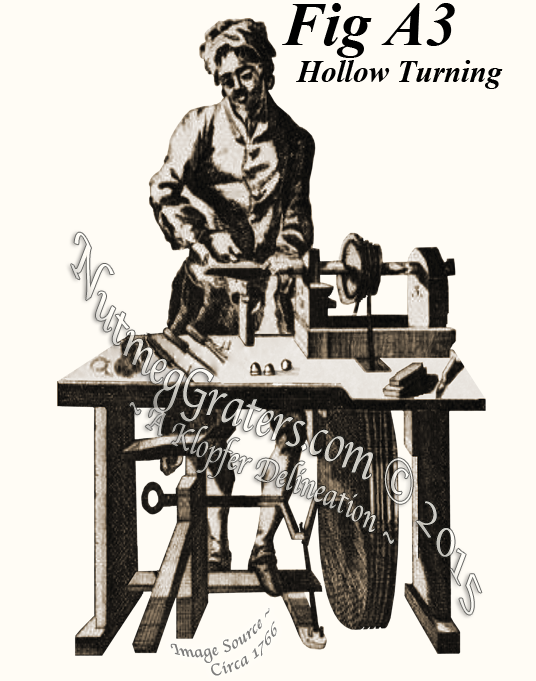 This process, known as ornamental turning, allowed specialized turners to create complex patterns on wood and/or ivory which were not possible with common hand turning. Inventing their advanced rose engine turning lathe, these unidentified, genius ivory turner(s) created small prized works of art in ivory. Puzzling, but the production of this high quality art ceased by the second quarter of the seventeenth century. For unknown reasons, this technology seems lost to time. To this day, these exquisite sixteenth century ivory turnings remain unsurpassed and nonpareil in complexity and design; their fragile refinement has never been rivaled.
This process, known as ornamental turning, allowed specialized turners to create complex patterns on wood and/or ivory which were not possible with common hand turning. Inventing their advanced rose engine turning lathe, these unidentified, genius ivory turner(s) created small prized works of art in ivory. Puzzling, but the production of this high quality art ceased by the second quarter of the seventeenth century. For unknown reasons, this technology seems lost to time. To this day, these exquisite sixteenth century ivory turnings remain unsurpassed and nonpareil in complexity and design; their fragile refinement has never been rivaled.
Carvers and turners created an expansive variety of ivory and bone utilitarian implements, to include charming pocket nutmeg graters. During the eighteenth and nineteenth centuries, these artisans were well versed in the spectrum of these materials; they knew the various properties for each material (uniformity in structure, hardness, formation, contours, size, cost and availability) and selected the material best suited for their commercial endeavors. Nutmeg graters were created arbitrarily using bone or ivory, occasionally combining both; sometimes incorporating ivory with exotic woods.
Eighteenth and early nineteenth century ivory/bond pocket nutmeg graters were individually crafted. Each was meticulously sculpted; each having delicate screw threading. The modern antique collector is astonished by the exquisite and precision quality workmanship achieved using, what appears to us, as very primitive equipment.
Identifying Characteristics of Ivory and Bone Through the Study of Nutmeg Graters:
For centuries, artisans searched to imitate the appearance of ivory. Cheaper or more available materials were sometimes substituted. In the nineteenth century, polished bone was used to give the look of ivory. Tagua nuts from South America were used instead of ivory to fashion small objects, such as buttons. During the early twentieth century, celluloids and plastics were introduced. In the 1920's, the DuPont Chemical Company created Pyralin, to include their ivory look-alike pattern, "Ivory Du Barry". This product was used to create dozens of household items (brushes, handles, jars, trays, boxes, clock cases, vases, etc.) and convincingly captured the Schreger line appearance, similar to that found in genuine ivory. So, how can we exclude these imitations?
Some ivory and bone nutmeg graters presented (below) within NutmegGraters.Com were analyzed by Donald E. Ridley (1927-2011). Mr. Ridley was a scrimshaw expert; forensic pioneer and author pertaining to natural biological materials of bone & ivory; a marine engineer; an historian of marine propulsion; and a member of the Scrimshaw Forensics Team at the New Bedford Whaling Museum in Massachusetts, USA. NutmegGraters.Com is pleased to share with our readers what Mr. Ridley so kindly shared with us.
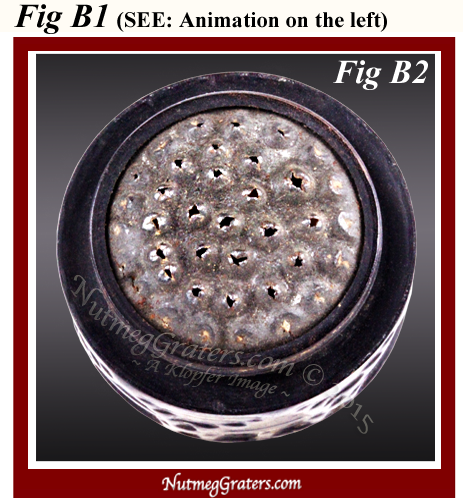
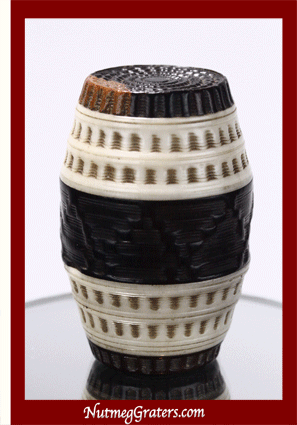 Don Ridley's simple, non-fail test to verify natural materials of bone or ivory from materials that are imitation or artificial, "use a black light in a darkened area, ... in a location that is lightless". Under black lighting, "there is an ultra violet response" and the bone or ivory fluoresce; materials such as vegetable ivory or faux synthetics (plastics) do not fluoresce.
Don Ridley's simple, non-fail test to verify natural materials of bone or ivory from materials that are imitation or artificial, "use a black light in a darkened area, ... in a location that is lightless". Under black lighting, "there is an ultra violet response" and the bone or ivory fluoresce; materials such as vegetable ivory or faux synthetics (plastics) do not fluoresce.
An Ivory and Treen Example:
The barrel nutmeg grater (Fig B1~2), is constructed using lignum vitæ and ivory, and composed from five fitted parts. Both ivory and lignum vitæ are very hard substances, requiring a high quality (expensive) precision lathe to cut them and an expertly trained artisan to shape them. A skillful, but unknown turner used an ornamental turning lathe fitted with a rose engine to carve the shallow relief design, decorating both the top and bottom covers. Notice the lignum vitæ mid-section pattern; the zig~zag design gives it the appearance of an irregular basket-weave pattern. The two scratch engraved ivory sections are absent from Schreger lines (Seen below in Fig F3), indicating a likelihood that the ivory is sperm whale. The sheet iron grater is tool punched with precision (Fig B2), a method indicating very early and meticulous handcrafting. Edward H. Pinto illustrated treenware made using similar workmanship and materials as products from London, but with certainty this nutmeg grater is English in its origin. Pertaining to barrel form pocket nutmeg graters, our evidence documents them as early as the 1750's; but based on construction methods and materials, this nutmeg grater could easily be of earlier manufacture.
A Bone and Treen Example:
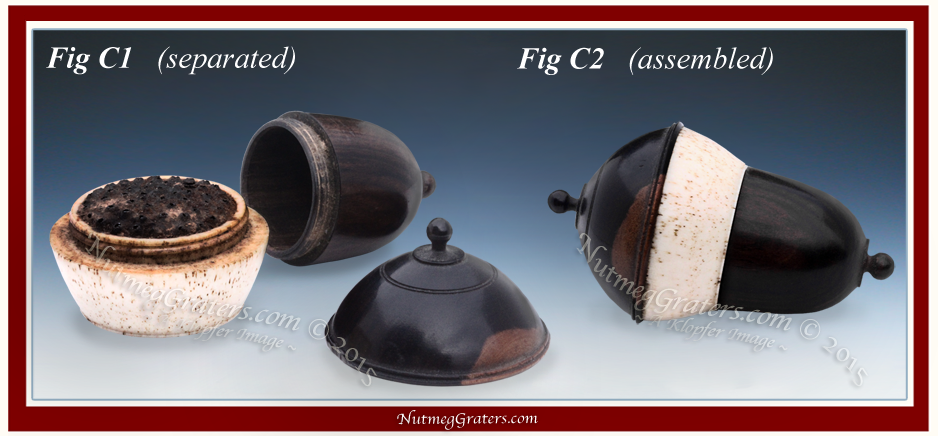
The acorn nutmeg grater (Fig C1~2), lathed as three sections, was constructed from lignum vitæ and bone. This is an example of hollow turning, its decoration achieved by simple shaping. The treen covers have two delicate end finials and the top cover is encircled with a simple double-lined band decoration Ridley identified the center section as "bone" explaining that "polished bone initially gives an appearance of ivory at the time it is made and that as items age, the dots and lines, typical of bone, become more pronounced." Because the artisan removed the outermost "cementine/dentine rings" surface during lathing, the specific type of bone can not be determined. Ridley indicated, "Although this is probably whale bone, only DNA analysis can forensically confirm this."
When compared to the barrel nutmeg grater (Fig B1~2), the acorn nutmeg grater (Fig C1~2) is surprisingly similar in internal construction. Notice that each sheet iron grater is mounted inside a stand away screw-mount which extends beyond a flat ledge ~ the sizing (thickness and height) of the ledge and screw-mounts appear identical with each nutmeg grater. Both sheet iron graters are hand punched in similar circular patterns, each with exacting preciseness. Based on construction, possibly both items were the products from the same turner's shop.
As detailed in advertisements (and other sources) appearing from the 1750's to the 1780's, both acorn form and barrel form nutmeg graters were listed for sale. Sometimes items were offered, giving customers a choice between these two shapes. Data shows that barrel form nutmeg graters continued in production through the 1830's, but that the manufacture of the acorn form nutmeg graters largely fell out of favor by the 1790's.
Three Elephant Ivory Examples:
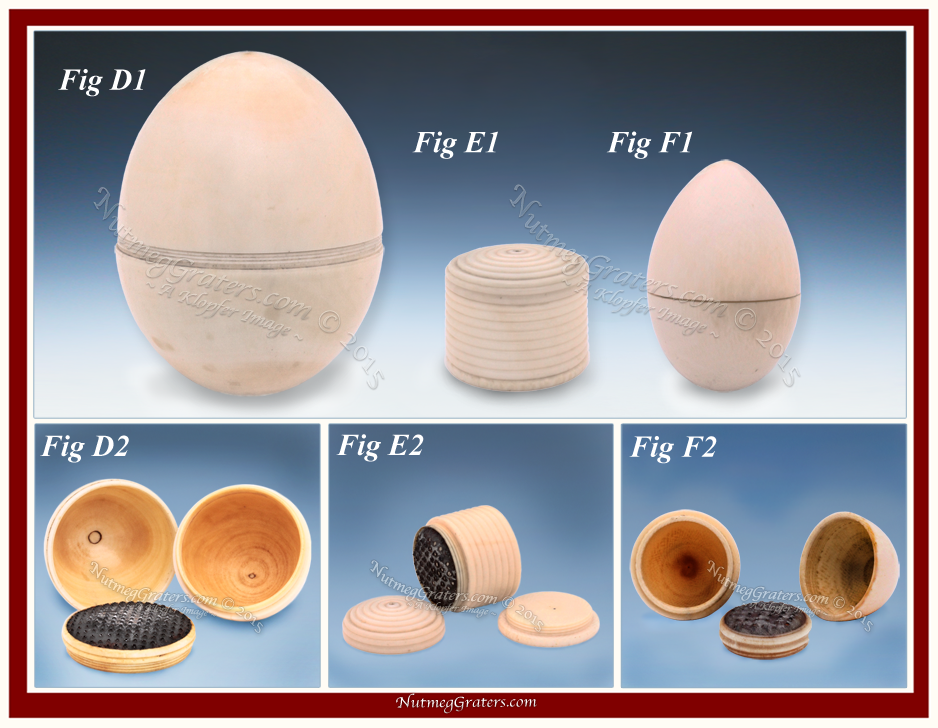
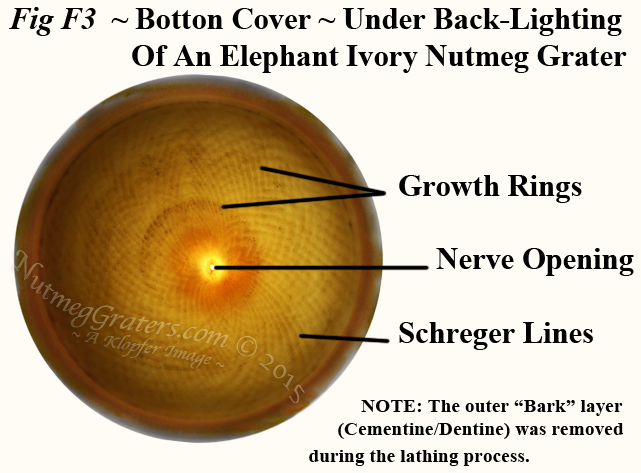
Asian elephants, Chinese elephants and African elephants are cousin species. The Chinese elephant perished about 1000 CE at which time the Chinese were already heavily engaged in trade with Africa for African elephant ivory. In the fifteenth century, Portuguese navigators began to haphazardly import ivory directly to craftmen, who fashioned their products for the aristocracy of Europe. By the second half of the seventeenth century, the Dutch East India Company harvested and exported commercial quantities of elephant ivory from their trade centers in Ceylon (Fig G) and were Europe's primary supplier. The largest ivory importation, according to Locke, occurred during the second half of the nineteenth century, when over a fifty year period ending in the year 1900, England had imported the tusks of more than 2 million African elephants.
Elephant ivory is most ideal for turning due to the regularity of its grain which evenly radiates from the center. Because their tusks are significantly larger, African elephant ivory was commercially preferred over Asian elephant. Moreover, both male and female African elephants have tusks; while only the male Asian (or Indian) elephants bear tusks, which are of small size. Asian elephant ivory is lighter in color, but significantly softer than African ivory. Therefore, African elephant ivory, while more prone to splitting, is more suitable for lathing.
Three elephant ivory nutmeg graters (Fig D1~2, E1~2, F1~2) were photographed using natural refracted photographic lighting in order to capture fine surface details (including naturally occurring blemishes) while eliminating reflective glare. Back-lighting of the bottom cover (Fig F3) was used to accentuate the distinctive features that are characteristic of elephant ivory. [As discussed below.]
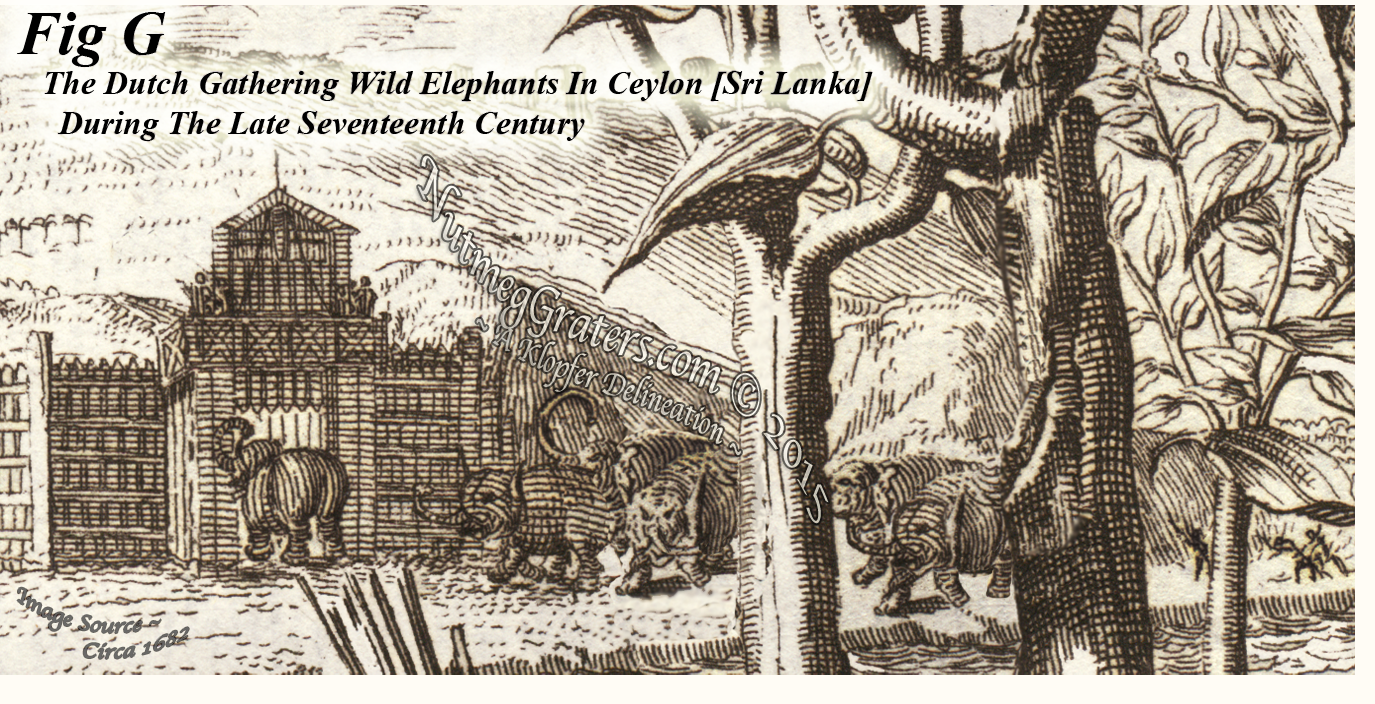 The egg form nutmeg grater (Fig D1~2) is an unusually large elephant ivory example (it is significantly larger than pocket nutmeg graters). The decoration is simple: a sculpted-band composed of three indented lines is carved around the upper exterior portion of the bottom cover. When opened (Fig D2), small ivory plugs are visible inside each cover; these were fitted to hide the space of the nerve openings. Precision threading allows both covers of this egg to screw together perfectly. A machine-stamped tin grater is fitted into a circular lathe-turned ivory housing which screws neatly inside the top cover.
The egg form nutmeg grater (Fig D1~2) is an unusually large elephant ivory example (it is significantly larger than pocket nutmeg graters). The decoration is simple: a sculpted-band composed of three indented lines is carved around the upper exterior portion of the bottom cover. When opened (Fig D2), small ivory plugs are visible inside each cover; these were fitted to hide the space of the nerve openings. Precision threading allows both covers of this egg to screw together perfectly. A machine-stamped tin grater is fitted into a circular lathe-turned ivory housing which screws neatly inside the top cover.
The short circular box form pocket nutmeg grater with a domed top cover (Fig E1~2) is elephant ivory. It is decorated with evenly carved ribbing. [NOTE: This pattern of raised bands is often seen on silver nutmeg graters that date from 1800 to about 1850.] Unassembled (Fig E2), there are threaded sections which meticulously fasten together. Notice the nerve opening appears as a black dot at the center of each lid. A machine-stamped tin grater is installed inside the stand away screw-mount.
The egg form pocket nutmeg grater (Fig F1~3), composed in three sections, is also constructed from elephant ivory. A machine-stamped tin grater (Fig F2) is mounted into a circular ivory jacket which screws neatly into the bottom cover. The screw fittings provide secure assembly.
Under back-lighting, the bottom cover (Fig F3) illustrates the characteristic that identify these nutmeg graters as elephant ivory. Elephant tusks radiate symmetrically away from the tooth's nerve and according to Ridley "display converging Schreger lines that angle at 115°." These angled Schreger lines are specifically distinctive and serve as the identifying feature that an object is actually that of elephant ivory. "Growth Rings" represent "concentric layer deposits", and appear as "circular bands" disseminating from the "nerve opening". [NOTE: Due to back-lighting, the nerve opening (Fig F3) appears as a white opening; however, under normal lighting, the "nerve opening" appears black, in color.]
All three elephant ivory nutmeg graters (Fig D~F) have provenance linking them to Great Britain. Machine-stamped tinned graters are useful to date these items as first quarter nineteenth century.
A Sperm Whale Ivory And Whalebone Example:
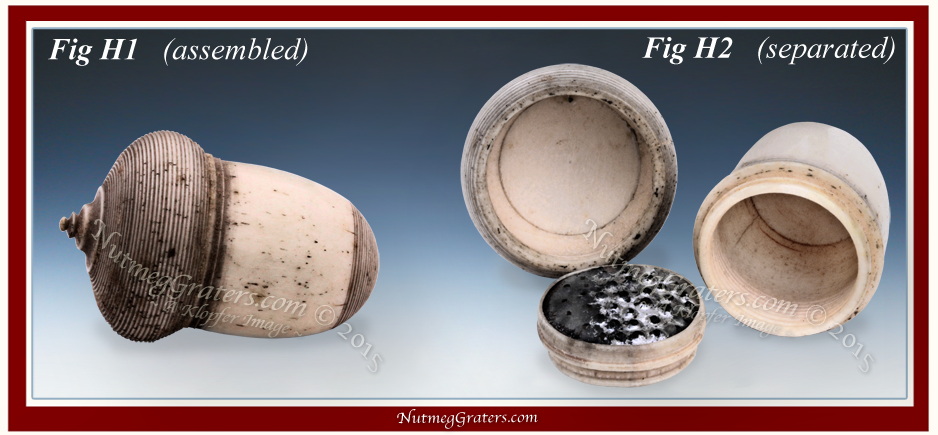
The acorn nutmeg grater (Fig H1~2) is constructed using sperm whale. Four bone pieces were lathed to create the top and bottom covers. Each cover consists of two fitted parts, as can be seen from the nutmeg grater's internal view (Fig H2). Upon examination, Ridley quickly identified the top cover's end cap as sperm whale ivory, saying "from the visual examination of the inside cover surface, it shows 'cementine and dentine rings' ~ this is typical of sperm whale." Each cover's side material shows the pronounced dots and lines which are typical of bone. Ridley described that "the turned sides are bone" ~ and that "because the end-cap is clearly of sperm whale, based on this and the match in color, the turned side pieces are also of sperm whale". Ridley identified that the bottom end cap as "ivory" but "due to it's small size, this part does not show the cementine or dentine evidence necessary to clearly determine which source of ivory it is. But it is probably sperm whale, too." He indicated that the fitted construction being of two pieces resulted in "the certainty" of developing its "strain cracks". He concluded that, "Drying out of bone or ivory creates a crack when it shifts and shrinks in relationship to the pieces it is joined to."
Adorning the cover, a top finial crests into three shallow circular tiers, while the remaining area is decorated entirely by sculped-banding. The plainish base side-unit terminates into an end-piece carved to match the sculped-banding pattern on the cover. The turner cleverly used the sculped-banding to camouflage the location where the fitted parts were joined. A hand punched tin grater (Fig H2) is mounted inside a ring-shaped ivory unit which screws neatly into the bottom cover, suggestive of second-half eighteenth century manufacture.
Two Dyed Ivory Nutmeg Graters: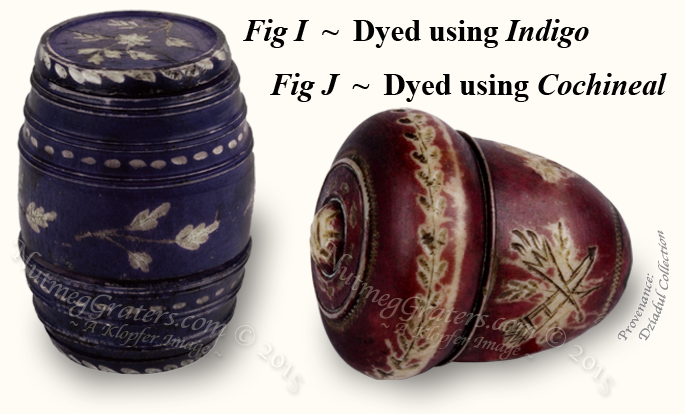
The barrel pocket nutmeg grater (Fig I) and the acorn pocket nutmeg grater (Fig J) are constructed from fitted pieces of ivory. Although ivory, the pieces are absent from Schreger lines, and are not elephant ivory. Following the lathe process, dyes were applied to their exterior, followed by the incised decorations cut into the surfaces. The acorn shaped grater shows trace amount of green coloring on the leaves that circumference the cover, as well as on its low relief finial.
Indigo dye was used to create a dark blue staining (Fig I). Indigo is extracted from the plant Indigofera tinctoria. Cochineal dye is used to create a dark red (crimson) staining (Fig J). It originates from the South American beetle, the dactylopius coccus.
Both indigo and cochineal dyes are ancient and became profitable export goods as early as the colonial period of the sixteenth century. Unlike most early natural dyes which often fade, both indigo and cochineal produced deep colors that are permanent. About 1840, commercial chemical dyes emerged, being perfected by the 1860's. Chemical dyes reduced the demand for natural indigo and cochineal dyes, replacing them entirely by World War I.
Having machine-stamped tinned graters, both dyed ivory nutmeg graters date to first quarter of the nineteenth century. Of special interest, the cochineal dyed acorn pocket nutmeg grater was photographed for publication, and appeared as "An acorn-shaped pocket grater of painted and incised ivory." Nutmeg Graters Variety and Spice, Early American Life, V.21, #2, P.54, April 1990.
Conclusion:
Nutmeg graters created in bone, ivory or in combination of both, or mixed with treen materials, are neither date marked nor maker marked. However, with certainty, they were produced at least by Circa 1750 through 1830. These dates are extrapolated from recorded evidence found in court records, newspaper advertisements, period novels and ship logs during this time span. Observing each of these works individually, Circa production dates are established by a). dating based on technological advances associated with the manufacture of the sheet iron or tin-plated graters (hand punched vs machine stamped), and/or b). comparison to dated examples of nutmeg graters in other materials (silver). Several of the nutmeg graters shown in this section, have direct British provenance, but all items are presumed to be of English manufacture. Our study of English Town and City Directories, ranging from 1722 to 1884, reveal that even the smallest communities list ivory, bone and wood turners and that the largest cities and districts list countless names of these artisans. Regardless, no specific manufacturer of these beautiful ivory and bone nutmeg graters is yet known.
Should you find information to confirm any manufacturer of bone and ivory nutmeg graters,
please let us hear from you!
One final note:
As a "Strategy to End Illegal Wildlife Trafficking", several nations have established trade restriction on ivory. Sellers of ivory must prove beyond any doubt that the ivory offered for sale complies with the Endangered Species Act. In the United States, ivory imported before the ban of 1989 or "Antique ivory" are exempt [NOTE: "Antique" specifically means "being 100 years old, or older".] These restriction seem to be in chronic flux.
Auction houses such as Christie's London warn:
"The USA has recently changed its policy on the import of property containing elephant ivory. Only Asian Elephant ivory may be imported into the USA, and imports must be accompanied by DNA analysis and confirmation the object is more than 100 years old. We cannot indicate whether the elephant ivory in a particular lot is African or Asian elephant. Buyers purchase these lots at their own risk..". ( 2015 )
For today's collectors, these concerns need be well studied. Good luck!
[KLOPFER article © September 2015]
